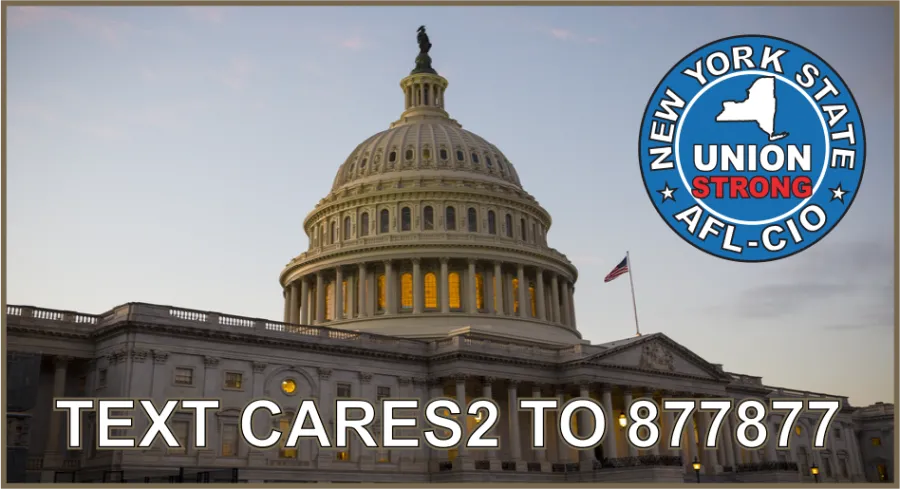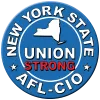New York Labor’s Priorities for CARES 2

The federal government has passed four rounds of COVID-19 emergency relief for essential workers as well as those whose lives and livelihoods have been impacted, but much more is required.
Text CARES2 to 877877 to take action! We will connect you with your member of Congress.
Our members are risking their lives to help their fellow New Yorkers, keeping them healthy, fed and safe, and they desperately need their country’s support and protection. Too many have inadequate personal protective equipment (PPE) and lack clear and sufficient government standards to keep them safe.
Members’ jobs have been eliminated with no certainty they will ever return. The numbers are simply staggering. Looking at the hospitality workforce alone, 95% of the hotel industry and 100% of the gaming industry in New York have been laid off. Emergency leave protections will help those who remain on the payroll, but too many workers do not qualify and the benefit levels for those who do will prove inadequate the longer this crisis persists.
State and local governments’ budgets have been ravaged, threatening the vital services New Yorkers are relying on now more than ever. Although, federal aid will assist in maintaining some critical services, more money with greater flexibility will be essential for our long-term success.
With these challenges in mind, Congress and the President must address the following priorities for the next relief package.
FRONT LINE WORKERS
Enact emergency OSHA standard for workers. Congress must statutorily create an infectious disease standard that protects all workers, including public workers in states that have not opted into OSHA coverage. Separately or in conjunction with that standard, it is critical steps are taken to ensure that all individuals who are at risk for exposure to COVID-19 through their work are provided with adequate PPE by their employers to keep them safe. In addition, health care workers and first responders need access to rapid testing and to be kept off the job if they test positive until they fully recover and test negative.
Recognize the sacrifices of frontline workers. Workers endangering their own well-being are earning well-deserved plaudits from the general public, the media, and elected officials. But in most cases those kind words have not been followed by hazard pay or like compensation. There is no amount of money that can compensate for their sacrifice, but additional financial renumeration may assist them and their families in dealing with the additional hardship their heroic work is causing.
STATE AND LOCAL GOVERNMENT FUNDING
Provide direct and more flexible aid. $500 billion is needed nationally for state and local governments, along with the flexibility in how the funding can be used to adapt to a rapidly changing reality, not just to pay for COVID-related expenses. At the core of this funding, we must ensure that agencies continue service and maintain the workforce providing them each day.
Increase Medicaid funding. As a growing population turns to Medicaid services, we need an increase in funding to ensure that the program is fully funded and that local governments can continue to provide all critical services.
Invest in Education. Replenish and enhance the educational stabilizationfundwith a focus on summer school, after-school programs, community schools and wraparound services to ensure continuity of instruction and meeting the social and emotional needs of children and families. The 2019-20 school year should not be chalked up as a loss; most districts were in school for a least seven months. To ensure we are building on that instruction, and not losing it, we need to plan for how to mitigate loss and inequity right now. This is in addition to emergency supplemental funding for Title I, the Individuals with Disabilities Education Act, and colleges and universities. This way, we can support the efforts districts and schools are making to help students—from pre-K to postsecondary—who have experienced extended months of learning loss, significant poverty, trauma, and social emotional needs.
SUPPORT FOR WORKERS AND THEIR EMPLOYERS
Expand emergency leave provisions. Emergency paid leave provisions exclude too many employers and provide the Secretary of Labor with the ability to exempt too many workers. We should be covering as many workers as possible, not building in loopholes. Congress must also remove limitations on duration as well as arbitrary benefit caps.
Ensure access to health care. Now more than ever, we must ensure that all working people can access the healthcare they need and deserve, including making widespread COVID-19 testing available, as that is the key to normalcy. Also, we must make affordable healthcare broadly available to those who are in need. Expanding Medicaid, reopening Affordable Care Act exchanges and having the U.S. government fully pay COBRA costs so anyone who had health insurance coverage can maintain their coverage are essential parts of the equation.
Safeguard the postal service. The value of the services provided by members employed by the United States Postal Service has never been clearer. Congress must appropriate funds to keep this vital service financially healthy through the crisis.
Direct stimulus to the hard-hit retail sector. Additional support for the retail sector should be included, such as rent forgiveness, increased payroll support, and tariff relief. These measures must be conditioned on companies receiving these benefits not unilaterally halting collective bargaining, or invoking Force Majeure provisions, and keeping all full-time employees who were on payroll prior to the shutdown. A Task Force consisting of the retail industry, unions, and workers must also be created to ensure adequate implementation of the above relief and to develop a Marshall plan for rebuilding the retail industry stronger than before.
Address gaps in aid to businesses. Programs created thus far are failing to get money out the door in a timely fashion, and that must be addressed. Union employers’ filing for the Payroll Protection Program have yet to receive funds with no signs of relief in sight. In addition, cultural institutions have been decimated, yet the SBA program under the first stimulus, for example, restricted loans and grants to employers with less than 500 employees, leaving out many of the major institutions. These institutions should also be made eligible with incentives and funding directly to keep people on payroll, rather than unemployment.
Deliver for unemployed workers. Continue pandemic unemployment compensation beyond its current expiration. In addition, although New York workers are eligible for unemployment insurance during strikes, some states do not allow these workers to claim benefits. Congress should ensure federal UI funds are made available to workers who are engaged in a strike. Finally, any individual performing services in an instructional or research capacity for an educational institution during one academic year or term shall not be disqualified from receiving benefits on the grounds that such individual has a reasonable assurance of performing such services in the succeeding academic year or term if the educational institution has been impacted by the COVID-19 health crisis.
ASSISTANCE FOR UNIONS
Uphold collective bargaining. Prohibit the rejection,abrogation or unilateral change of any collective bargaining agreement byany entity that received or will receive federal COVID-19 financial assistance or used cash to make a share repurchase in the preceding five years or five years from the last day of the use of a federal credit instrument(s). In addition, labor neutrality provisions should be expanded across the various forms of aid.
Protect pension plans. Pension plans are being decimated by the decline in the markets and reductions in employer contributions due to members being out of work. To ensure the retirement security of individuals who work their entire life with the promise of a pension when they need it, the United States must shore up pension plans impacted by COVID-19. Multiemployer pension plans had already been facing an existential crisis, which has only been exacerbated by the current emergency. The creation of a special partition program, an extended amortization of loses, and targeted financial assistance are essential.
Assist the unions who are assisting workers. Unions and their associated benefit funds should be eligible for various forms of assistance offered to corporations to keep their workers on the payroll. Yet under the CARES Act’s Payroll Protection Program, 501(c)3s are the only not-for-profits that qualify. This inequity should be corrected in forthcoming legislation.
Do right by those doing right. Provide economic support for multiemployer health plans that are waiving cost-sharing or keeping ineligible members on their plans for reasons related to the COVID-19 pandemic.
INFRASTRUCTURE
Put New Yorkers back to work by investing in infrastructure. In response to past economic crises from the Great Depression to the Great Recession, our country has recognized that building our infrastructure is one of the most effective ways to get workers back on the job, while simultaneously investing in our future. This crisis deserves no less of a response, particularly given the urgent need for new and improved roads, bridges, mass transit, water, energy and communication infrastructure.
Everyday New Yorkers are rising to the occasion. They have inspired all with their dedication and personal sacrifice. The least they can expect is for their elected officials to demonstrate the same level of urgency and selflessness.
